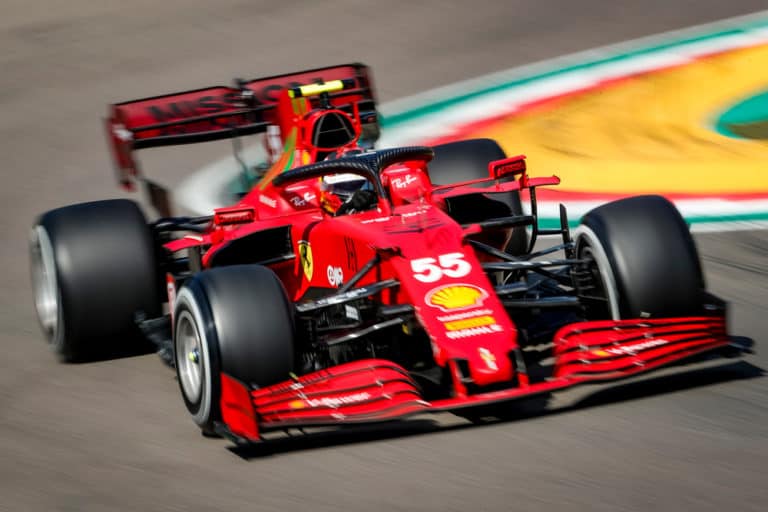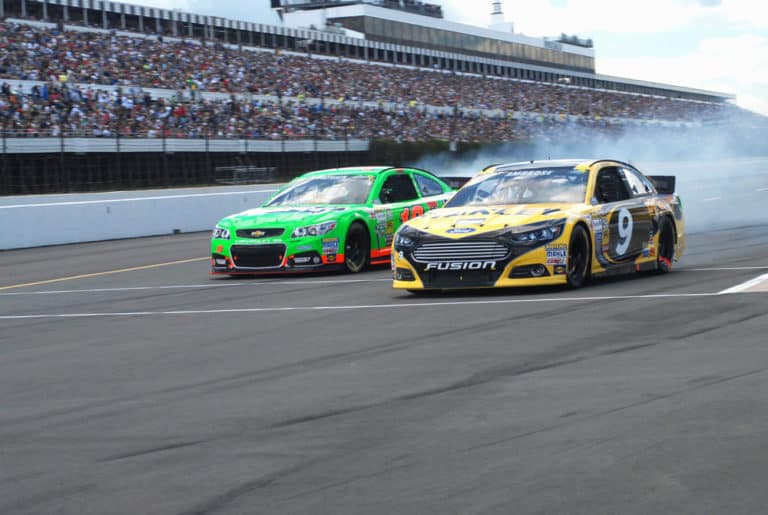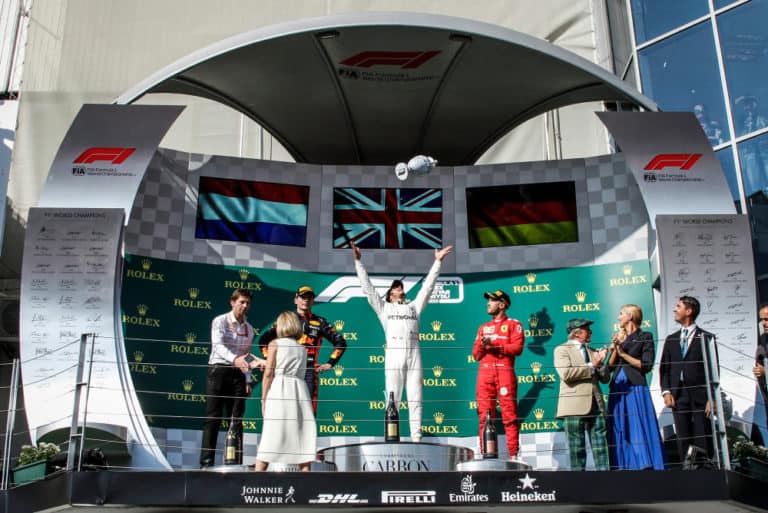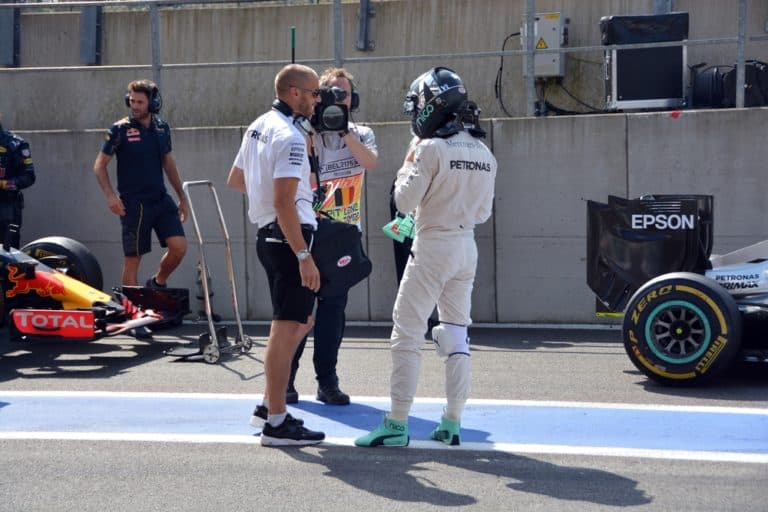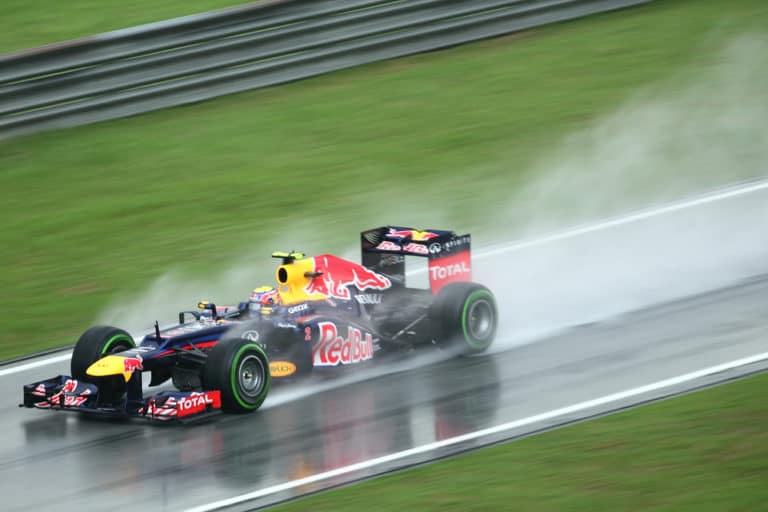Editorial credit: Jay Hirano Photography / Shutterstock.com
Since its inception in 1950, Formula 1 has visited 34 different countries around the world. In its 72 seasons, there have been 1,079 world championship events under 53 race titles at 76 different circuits.
Some circuits, such as Spa-Francorchamps in Belgium, Monza in Italy, or Silverstone in the United Kingdom, have become some of the most legendary circuits in motorsports, being a constant on the calendar and causing their respective countries to host numerous races over time.
On the other hand, other circuits and countries have passed through the Formula 1 calendar with more pain than glory, holding races on rare occasions and not being maintained over time. Therefore, today we will see which countries have hosted the most Formula 1 races.
1. Italy, 104 Races
Italy is the only country to have hosted at least one race in every season since 1950. The fast and mythical Monza circuit has hosted the Italian Grand Prix every time, except for 1980, when it was renovated and replaced by the Imola circuit.
Imola was so popular with drivers and fans that from 1981, it hosted the San Marino Grand Prix until 2006. After that, the circuit did not return until 2020, after the changes produced in the calendar by the Covid-19 pandemic, celebrating from that moment the Grand Prix of Emilia Romagna, which is still present since then.
The Pescara street circuit, which at 25.800 kilometers long is the longest in F1 history, hosted the Pescara GP in 1957, and Mugello, which hosted the Tuscany GP in 2020, are the other two races that have been held in Italy throughout history.
2. Germany, 79 Races
After Italy, Germany, with 79 races, is the country that has hosted the second most Grands Prix in the history of Formula 1. Germany has not hosted a Formula 1 Grand Prix on only 7 occasions: 1950, 1955, 1960, 2015, 2017, 2021, and 2022.
Most races in Germany have been held at two of the world’s most iconic circuits, the Nürburgring and Hockenheim. All German Grands Prix have been held at these two circuits, except for the 1959 edition, which was held at AVUS in Berlin.
The Nürburgring has also hosted the European Grand Prix 12 times between 1984 and 2007, the Luxembourg Grand Prix in 1997 and 1998, and the 2020 Eifel Grand Prix, making it the first circuit to host Formula 1 races under four different event titles.
Despite being a classic, the German Grand Prix has lost strength over the last decade, falling out of the championship on several occasions due to economic support in favor of new circuits such as those in the Middle East, as has been the case for the last 2 years. In 2023 it will not be present either.
3. United Kingdom, 77 Races
Along with the Italian Grand Prix, the British Grand Prix is the only event that has been on the Formula 1 calendar every year since the first season in 1950. In the 73 years of F1, Silverstone has hosted the British GP on 56 occasions, uninterruptedly since 1987.
From 1955 to 1962, Silverstone alternated with Aintree, which hosted 5 Grands Prix, and between 1963 and 1986, with Brands Hatch, which hosted the event on 12 occasions.
The United Kingdom also hosted the European Grand Prix on 3 occasions, in 1983, 1985, and 1993, held at Brands Hatch the first two times and at Donington Park in 1993. In addition, Silverstone hosted a second race in 2020, the 70th Anniversary Grand Prix.
4. United States, 73 Races
The United States is the country that has hosted the most different Grands Prix, with 7 Grands Prix held at 11 different venues in 73 races. During the 1950s, the Indy500 counted towards the drivers’ championship, and although it was not run under Formula 1 rules, it was included as an extra event.
In 1959 the United States Grand Prix began to be hosted, first at Sebring and in 1960 at Riverside. From 1961 to 1980, it was held at Watkins Glen, which with 20 races, is the circuit that has hosted the United States Grand Prix the most times. Between 1989 and 1991, it was held in Phoenix, between 2000 and 2007 in Indianapolis, and since 2012 it has been held in Austin, Texas.
Between 1976 and 1983, there was a second Grand Prix in the United States, the United States Grand Prix West, held in Long Beach, California, and in 1981 and 1982, there was another race, the Caesars Palace Grand Prix, held in the Las Vegas street circuit.
The Detroit Grand Prix, held between 1982 and 1988, and the Dallas Grand Prix, held only in 1984, is the other Formula 1 event that the United States held during the second half of the 20th century.
The American company Liberty Media, which acquired the Formula 1 rights in 2017, wanted to boost the category in the United States, including from 2022 a second Grand Prix, Miami, and from 2023 Las Vegas will return, hosting the Las Vegas GP.
5. Monaco, 68 Races
The Monaco Grand Prix is perhaps the best-known motor racing event of all. It has been held since 1929 in the streets of the Principality. It has become one of the most prestigious and important races of all, forming, together with the Indianapolis 500 and the 24 Hours of Le Mans, the so-called Triple Crown of Motorsport.
The Monaco Grand Prix was present in the first season in the history of Formula 1 in 1950, and after being out for 3 years, in 1954, it came back to stay, being held uninterruptedly until 2019.
In 2020 it could not be held due to the Covid-19 pandemic, but it returned to the calendar after that. Ayrton Senna, with 6 victories, is the absolute king of Monaco, one of the most difficult circuits of all, where only the best win.
6. Belgium, 67 Races
The Belgian Grand Prix, along with Monaco, is one of the oldest events of all. It has been held since 1925, and since the creation of Formula 1, it has not been held only 6 times: 1957, 1959, 1969, 1971, 2003, and 2006.
Spa-Francorchamps hosted the Grand Prix until 1970, after which it was left out due to safety concerns with the track, one of the longest on the calendar in a region with a changing climate, whose facilities were outdated.
The Nivelles circuit hosted the Belgian Grand Prix in 1972 and 1974, Zolder in 1973 and 1975 to 1982. Spa returned in 1983, and in 1984 it was again replaced by Zolder, but from 1985 Spa returned to hold the GP unanimously.
7. France, 63 Races
France has hosted 62 French Grand Prix and one Swiss Grand Prix in 1982, held in Dijon. With the exception of 1955, due to the disaster at the 24 Hours of Le Mans, in which 83 spectators and the French driver Pierre Levegh died, the French GP was held in every season from 1956 to 2008.
Reims, Rouen, Charade, Le Mans, Dijon, and Paul Ricard alternated over the years to host the Grand Prix until 1990. From 1991, Magny-Cours was the venue that hosted the GP, until 2008.
After 10 years of absence, the French GP returned in 2018 at the renovated Paul Ricard, being held until 2022, with the exception of 2020 due to calendar changes brought about by the Covid-19 pandemic.
However, the Grand Prix has been left out for the 2023 season.
8. Spain, 59 Races
The first Spanish Grand Prix was held in 1913, no less. In Formula 1, Spain has hosted fifty-two Spanish Grands Prix and seven European Grands Prix, in six different circuits: Pedralbes, Jarama, Montjuic, Jerez, Catalunya, and Valencia.
In the 1950s, Spain was only present in the calendar on 2 occasions, 1951 and 1954, races held in Pedralbes. From 1968 to 1981, the Spanish Grand Prix was alternated between Jarama and Montjuic, and after a break of several years, from 1986 to 1990 it was held in Jerez.
Since 1991, the Spanish Grand Prix has been held at Circuit de Barcelona-Catalunya, which has also hosted some pre-season days. As for the European Grands Prix that Spain has hosted, two were at Jerez, in 1994 and 1997, and five at the Valencia Street Circuit, between 2008 and 2012, before it was abandoned.
9. Canada, 51 Races
Since the first race held in Canada in 1967, the country has remained one of the most consistent on the calendar, failing to appear on only 5 occasions: 1975, 1987, 2009, 2020, and 2021.
From 1967 to 1974, the Canadian Grand Prix alternated between two circuits, Mosport Park and Mont-Tremblant. In 1975 the GP was not held due to the safety concerns of the Mont-Trembant circuit, and Mosport held the 1976 and 1977 races, to be later replaced by the then-called Circuit Île Notre-Dame, on the island of Notre Dame in Montreal, today known as Circuit Gilles Villeneuve, in honor of the legendary Canadian driver.
Since then, the Canadian Grand Prix has been held every year at the same venue, and only on 4 occasions has it failed. In 1987 it was not held due to a sponsorship dispute between Labatt and Molson, in 2009 it was simply removed from the calendar and in 2020 and 2021 it was left out due to calendar changes brought about by the Covid-19 pandemic.
10. Brazil, 49 Races
The Brazilian Grand Prix was held for the first time in 1972, at the same time that Brazilian drivers such as Emerson Fittipaldi and Carlos Pace were rising in the category. Between 1972 and 1977, the Grand Prix was held at the Interlagos circuit, located in the city of Sao Paulo.
In 1978, the Grand Prix was held at Jacarepaguá, located in the city of Rio de Janeiro, and after two editions at Interlagos in 1979 and 1980, the circuit hosted the Brazilian Grand Prix from 1981 to 1989, while Interlagos underwent major renovations to adapt to the new times in terms of safety.
Interlagos returned in 1990 and held the Grand Prix uninterruptedly until 2019. Like many other Grand Prix on this list, the race was not held in 2020 due to the Covid-19 pandemic, but returned in 2021, under the name Sao Paulo Grand Prix.
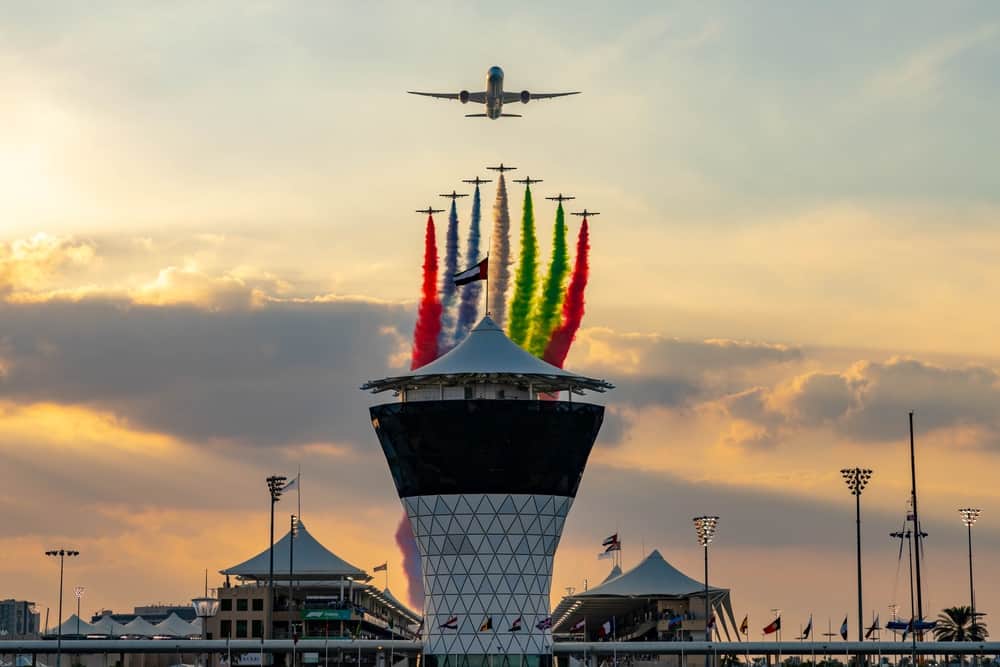
11. Japan, 38 Races
The Japanese Grand Prix was the first Formula 1 race held in Asia, in 1976, and since then it has always been one of the last races on the calendar, where great battles for the title have taken place.
The 1976 and 1977 Japanese Grands Prix were held at Fuji Speedway, and after 10 years off the calendar, the GP returned in 1987, being held until 2006 at Suzuka Circuit. In 2007 and 2008, the Japanese Grand Prix returned to Fuji, which had been renovated, and there were plans for it to alternate with Suzuka thereafter.
However, from 2009 onwards, it was once again run exclusively at Suzuka, due to the crisis of the powerful Japanese brand Toyota as a result of the 2008 recession, and since then it has remained constant in the calendar, with the exception of 2020 and 2021.
Japan also held the Pacific Grand Prix twice, in 1994 and 1995, at the Okayama International Circuit, better known as IT Circuit.
12. Austria, 37 Races
Two different circuits have hosted the Austrian Grand Prix. The Zeltweg Airfield hosted the Austrian GP from 1963 to 1968, although only the 1964 edition scored for the world championship.
It was from 1969 (being scoring for the championship from 1970), that the Spielberg circuit, originally called Österreichring, then A-1 Ring, and currently Red Bull Ring replaced it. Curiously, both circuits are only 4 km apart, in the southeast of Austria.
The Österreichring hosted the Austrian GP until 1987, after which it was off the calendar for 10 years due to safety concerns. It returned in 1997 after a complete remodeling of the layout and infrastructure, under the name A-1 Ring, hosting the GP until 2003.
After that, the circuit was disused again for 10 years, and returned to the calendar in 2014, after the purchase by Red Bull and a new modernization. Since then, it has remained constant on the calendar, and in 2020 and 2021, due to changes in the calendar, it hosted a second race, the Styrian GP, referring to the region in which the circuit is located.
13. Hungary, 37 Races
The Hungarian Grand Prix was held only once before World War II, in 1936, at Népliget, a park in Budapest. After that, it was not held again until 1986, when Bernie Ecclestone expanded Formula 1 behind the Iron Curtain.
Since then, the Hungarian Grand Prix has been held uninterruptedly at the Hungaroring in Mogyoród, near Budapest. Lewis Hamilton, with 8 victories, is the most successful driver on the Hungarian circuit, while McLaren, with 11, is the most successful team.
Interestingly, the Hungaroring was the only current Grand Prix venue that had never seen a wet race until the 2006 Hungarian Grand Prix.
14. Australia, 36 Races
The Australian Grand Prix has been part of the Formula 1 championship since 1985, and since then has only been absent in 2020 and 2021 due to the Covid-19 pandemic. The Australian Grand Prix is one of the oldest of all, having been held since 1928.
Until 1984, before becoming a scoring event of the F1 championship, the Grand Prix changed venues on numerous occasions, being held at up to 21 different circuits. As an official F1 championship event, the Adelaide Street circuit hosted the Grand Prix until 1995.
In 1996, the Adelaide circuit was replaced by Albert Park, a semi-urban circuit located in the park of the same name in the city of Melbourne, as part of the plan to modernize and boost tourism in the city by the mayor at the time.
Albert Park has become one of the modern classic circuits, much loved by drivers and fans, where Michael Schumacher, with 4 victories, is the most successful driver in history.
15. Netherlands, 32 Races
If we had made this list 30 years ago, the Dutch Grand Prix would have been in the top 5, since from 1952 to 1985 it was off the calendar only 4 times: 1954, 1956, 1957, and 1972. However, the Dutch Grand Prix was not held since 1986 until it returned in 2021.
The Grand Prix has always been held at the Zandvoort circuit, which started hosting races in the 1930s. Until the 1980s, the Zandvoort circuit was very different from the current version, much longer and faster, as it connected some of the surrounding roads, which is why it was modified and redesigned on numerous occasions.
In the late 1980s, the layout was completely redesigned, keeping only a small part of the original circuit, and creating a much more twisty and curvy circuit, and used for a large number of competitions, until Formula 1 returned in 2021. Some areas of the circuit were modified to accommodate the category.
Max Verstappen has won both editions held so far at Zandvoort in front of his fans.
16. South Africa, 23 Races
Like the Dutch Grand Prix, South Africa was also very present during the 20th century. The first South African Grand Prix was held in 1934 and was held regularly from 1962 to 1985.
The Grand Prix was hosted at the Prince George Circuit in East London in 1962, 1963, and 1965, which was the circuit where the first races had been held in the 1930s. From 1967, the Kyalami circuit hosted the Grand Prix until 1985, becoming one of the most popular events among fans and drivers.
However, beginning in 1985, the South African Grand Prix was cancelled due to the apartheid nation’s policies. After the end of apartheid in 1991, Formula 1 returned to Kyalami in 1992 and 1993, but after that, it was not held again.
In recent years there has been renewed talk of a possible return of South Africa to Formula 1, although at the moment there is nothing official, and everything is speculation.
17. Mexico, 22 Races
The Grand Prix of Mexico was held from 1963 to 1970 at the Magdalena Mixhuca, located in Mexico City, where Jim Clark, with 2 victories, was the most successful driver. The Grand Prix returned in 1986, being hosted until 1992 at the same circuit, under the name of Hermanos Rodriguez, named after drivers Ricardo and Pedro Rodriguez.
After 1992, the Mexican Grand Prix was not held again until 2015, in the renovated Hermanos Rodriguez, being present since then except for the 2020 edition, where Max Verstappen has been the undisputed king of the track, obtaining 4 victories.
It is one of the most popular events on the Formula 1 calendar, attracting thousands of fans who congregate in the so-called stadium area of the circuit, which is quite spectacular.
18. Argentina, 20 Races
The Argentine Grand Prix was held intermittently from 1953 to 1998, all at the Buenos Aires Autodromo, in 4 different configurations. The first races in Argentina began in the 1930s, and it was part of the Formula 1 calendar from 1953 to 1960 (except for 1959, which was not held), where it was run in the number 2 configuration.
In 1972, the Grand Prix returned, running for 2 years in the number 9 configuration and another two in the number 15 configuration, where it was also run from 1977 to 1981.
After that, it was not held again until 1995, when it was run in number 6 configuration until 1998. Since that season, Argentina has not hosted any other Formula 1 Grand Prix, and since 2001 it has not had any driver in the category either.
Conclusion
The Formula 1 calendar is constantly evolving, always expanding into new countries and circuits while leaving others behind, but always seeking to offer entertaining and dynamic racing.
Many are the venues that the category has visited since 1950. As mentioned above, some have remained constant over time, becoming true icons, while others have had a brief or intermittent presence in the category.

